Salvage of the Squalus
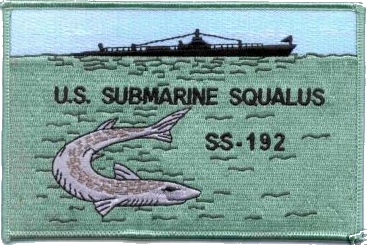
by Ellis Royal Cross
0n May 23, 1939, the United States submarine USS Squalus sank off Portsmouth, New Hampshire, with all hands. But 32 of the crew plus one civilian worker were rescued the next day. One hundred thirteen days after the disaster the Squalus was in dry dock. It had been raised from 242 feet by the valiant efforts of 53 divers. They risked their lives making 640 dives during the desperate, frustrating work. For the sixth and last time, the Squalus had been raised.
This is the story of the 113 days; of the first use of oxygen helium for deep diving in the open sea; of blow-ups from 240 feet of water; of bends cases and accidents; of the terrible danger to men working to rig pontoons weighing 35 tons each in strong currents and heavy surge; of the striking success of some divers and the stark failure of others; and of anxiety, euphoria, and unconsciousness caused by nitrogen narcosis.
The Squalus
In May 1939, the USS Squalus (pronounced "skwaylus") was one of the U.S. Navy's newest S-type submarines. She was 310 feet long and displaced some 1,450 tons on the surface and 2,000 tons when submerged. She could cruise on the surface 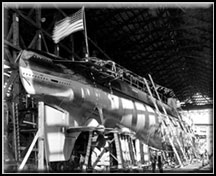 at 16 knots. Except for one test run the boat had completed her builders' trials. That last test run was to be a crash dive from the surface-cruising at 16 knots-to a depth of 50 feet in only 60 seconds. 'Me order, "Take her down," was given by Commanding Officer, Lieutenant Oliver Naquin, at 0840 on May 23,1939. Within five minutes, the Squalus rested on the bottom in 242 feet of water with her three after compartments flooded and 26 other crew dead. The forward two compartments were not flooded and 32 men were rescued during the next 40 hours.
at 16 knots. Except for one test run the boat had completed her builders' trials. That last test run was to be a crash dive from the surface-cruising at 16 knots-to a depth of 50 feet in only 60 seconds. 'Me order, "Take her down," was given by Commanding Officer, Lieutenant Oliver Naquin, at 0840 on May 23,1939. Within five minutes, the Squalus rested on the bottom in 242 feet of water with her three after compartments flooded and 26 other crew dead. The forward two compartments were not flooded and 32 men were rescued during the next 40 hours.
The last man was rescued from the Squalus a few minutes past midnight on May 25, 1939. According to a Naval officer, "We have finished lifesaving and our task has turned to that of salvage."
The Salvors
 A fleet of watercraft of all sizes had gathered over the stricken submarine. The key vessel was the submarine rescue and salvage ship USS Falcon, Lieutenant George Sharp commanding. The Falcon was an ex-minesweeper first commissioned in 1918 during WW 1. Later converted to a submarine rescue and salvage ship, she had been used to raise the USS S-51 sunk off Block Island in 132 feet of water in September 1925 and in recovering the USS S-4 from 104 feet of water in December 1927. The Falcon and her crew were not strangers to submarine disasters.
A fleet of watercraft of all sizes had gathered over the stricken submarine. The key vessel was the submarine rescue and salvage ship USS Falcon, Lieutenant George Sharp commanding. The Falcon was an ex-minesweeper first commissioned in 1918 during WW 1. Later converted to a submarine rescue and salvage ship, she had been used to raise the USS S-51 sunk off Block Island in 132 feet of water in September 1925 and in recovering the USS S-4 from 104 feet of water in December 1927. The Falcon and her crew were not strangers to submarine disasters.
On this operation the Falcon would serve a dual work role. Primarily she would be a diving platform. She would also provide hyperbaric: facilities for surface decompression procedures and for treatment of diver diseases or accidents.
The sister submarine USS Sculpin was there, too. The crew of this vessel had located the sunken Squalus and would now provide reserve air and other support. She was also a valuable reference for those diving on the Squalus. Since they were identical vessels, the divers could locate on the Sculpin the fittings, valves, compartments, etc., they were going to work with on the Squalus. The Sculpin also served as flagship for Admiral Syrus Cole, commander of the salvage force.
Some of the Navy's top diving and submarine experts were at the scene: Lieutenant Commander F. A. Tusler was the salvage officer. Also, Lieutenant Commander Momsen, who had developed the Momsen submarine escape lung; Commanders A. 1. McKee and A. R. McCann, developers of the submarine rescue bell; Navy diving medical specialists doctors Behnke, Yarborough, and Willmon. And, there were the hundreds of enlisted men and 53 divers.

The Divers
A total of 53 divers worked on the rescue of the sub crew and on a job that is referred to as one of the greatest salvage efforts of all time.
Navy divers are, invariably, tough, healthy, easygoing when not diving, psychologically well adjusted and liked by the rest of the world. But working at a depth of 240 feet put physiological and psychological stress on them they had never before experienced. The extremely cold water, currents, darkness, the weather and, frequently, lack of proper equipment and the use of new, untried equipment, caused further stress. Not one of all the divers was able to complete all of the objectives of his dives. In spite of this the salvors scored a striking success in raising the sub.
The plan finally approved for the salvage involved techniques and equipment first used to raise the submarine F-4 sunk off Honolulu in 306 feet of water in March 1915. Some refinements were made in both equipment and techniques in the later salvage of the S-51 in 1925 and the S-4 in 1927.
Basically, the plan involved placing heavy chains and lifting slings under the bull in both the bow and stem sections of the boat. The salvage pontoons, themselves small vessels, were 32 feet long, 12.5 feet in diameter and weighed 35 tons. Each was capable of lifting 115 tons (80 tons net lift). They would be rigged to the lifting chains over the flooded stern, four over the bow for the first lift. In addition, some of the compartments on the Squalus could be blown dry to obtain additional buoyancy.
In order to prevent an uncontrolled blow-up of the sub from deep water, it was to be raised in three stages. First, from the depth of 242 to about 160 feet; then to a depth of about 90; and finally to a depth that would permit drydocking. At the 90 foot depth divers could work long enough to close hatches and prepare the submarine for final tow into the harbor and drydocking.
Day 1: May 26
The first day of salvage started early. Falcon was shifted from her mooring used for the rescue work until she was in a better position for the salvage work. By 1130 the new moor was completed. At 1136 diver J. J. Alicki went over the side and at 1140 reported he was on the deck of the Squalus. Diver F. E. Smith left the surface at 1141 and landed on the vessel at 1144. Both men used compressed air and standard Navy MK-V helmet diving gear. Their job was simple-attach a four inch diameter Manila line to the rail of the sub that would be used as a descent and ascent line by the divers.
Alicki reported he was unable to drag the heavy line forward and had gone back to see why Smith was not feeding him slack. He stated, "Smith was sitting on deck with his back to the rail. I let the rope go, checked Smith's control valve to see if he was getting air. Then I jerked him a few times and tried to talk to him." Alicki reported he felt very tired while on the bottom. Smith states, "I landed on the deck of the sub and was waiting for the line to come down. My next recollection was of awakening from a deep sleep. I must have passed out instantly as I have no recollection of going to sleep. I had no bad feelings before or after."
The next dive was to a depth of only 102 feet to clear some wires that had become fouled. The time of the dive was 15 minutes and it was completed without incident. Then (boson) Crandall made a dive on compressed air to the deck of submarine. He left the surface at 1524. At 1529 Crandall reported he was on the sub. Two minutes later his speech became incoherent and rambling. He was ordered to come up and was on the decompression stage at 1536. There had been four dives and three failures. Nitrogen narcosis had exacted its toll. It was thought the ship's diving air supply might not be properly filtered for such deep diving. Lieutenant Willmon, a diving physiologist, and William Badders started a dry dive to 300 feet on air in the recompression chamber to test the air supply. At a depth of 2 10 feet the air supply was exhausted. They had to surface.
Day one was over. It seemed to presage the way the salvage job would go during the next 112 day.
Use of Heliox
Experimental work with heliox (helium oxygen) diving began with the Navy in 1924 and continued through 1940. In the later stages it was at the Navy s Experimental Diving Unit. By 1943 wet dives to 500 feet in experimental dive tanks and open sea dives to 440 feet had been made. In 1937 Max Gene Nohl made a test dive to 420 feet in Lake Michigan. Contrary to expectations, the use of heliox mixes did not permit material reduction in decompression time. However, it allowed much deeper dives to be made with greater safety.
Several divers who had been rushed to the Squalus salvage had been stationed at the U.S. Navy Experimental Diving Unit at Washington, D.C. They had been working on developing and testing heliox for diving. However, this mixture had only been used experimentally under carefully controlled conditions.
In conventional air-supplied helmets, air freeflows constantly into and out of the helmet. Part is inhaled and then exhaled by the diver but there is no recirculation or reuse of any of the air. In the heliox mode a diving helmet has additional valves, a venturi system for recirculating the mixed gas from the helmet through a carbon dioxide absorbing canister and chemical. While the gas supply is still basically in a constant flow state, the volume of gas actually needed by the diver is small when compared with a conventional air supply system.
The 1943 U.S. Navy Diving Manual states, "Oxygen helium mixtures were used almost entirely by the divers in the salvage of the USS Squalus. . . ." It is true, heliox mixes were used to some extent during the salvage but not nearly as much, and not with as much success, as almost all writers have indicated.
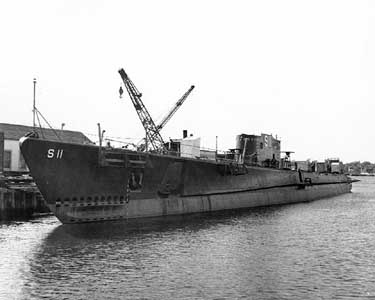
Day 2: May 27
On this day the first field trial of the Navy's heliox diving rig was made by F. H. O'Keefe. His dive started at 1006. He descended to 50 feet for 15 minutes. 'Me item of note in the log was that his nose was skinned by the tenders when they put his helmet over his head.
Later on day two, at 1130, R. M. Metzger made a test dive with the heliox rig to 100 feet. Everything worked well. Metzger stated, "I felt normal at all times. No aftereffects."
At 1255 the first working dive ever with a heliox rig was attempted by William (Bill) Badders, an excellent choice for this test of man and equipment in deep water. He was dressed in the special helmet. He landed on the sub at 1308 and reported he was near the deck gun just aft the conning tower. He tried to drag the four inch descending line into position. According to Badders, "As I reached the gun the recirculator on the helmet seemed to gradually be losing gas supply. I opened the main control valve and the recirculating venturi tube seemed to start functioning properly again for about one minute, then started to slow down again. I felt as though I were being overcome with CO 2* 1 made sure I was clear and notified topside to start bringing me up immediately. As I approached the surface my physical well being improved. I was then brought to the surface for decompression."
At 1511 A. W. Pickering made a 240 foot dive on compressed air. He was able to secure the descending line to the sub. He completed the job in nine minutes and surfaced with no ill effects. Badders and Pickering were out of the decompression chamber at 1634.
So ended day two. One line had been attached to the sunken sub.
The third and fourth uses of heliox diving systems were made on day three. Zampiglione and Gilbert descended to the submarine. Zampiglione reported no problems during a 33 minute dive. Gilbert reported that the breathing gas seemed to be shutting off at irregular intervals. Also, the main control valve failed to deliver adequate gas and his dive was aborted.
On day four Bill Badders and A. J. Vanderhayden made dives on compressed air to 240 feet. Air rushing into Badders' helmet, effects of nitrogen narcosis, and the poor quality of the telephone system available made good communication impossible and the dive was terminated. Vanderhayden reported, "The dive was normal in all respects and I felt good at all times." In use at that time was the Pittsburgh sound powered telephone. Day 5: May 30
One diver reported: "Telephone reception very poor. Turned my air down to hear. From then on I felt kind of woozy. Before I could get back to normal, I was hoisted up." A second diver stated, "After reaching the submarine I waited a minute or two before attempting any work as my head was not exactly clear." Later this diver opened his helmet exhaust fully and increased the flow of air through his helmet. He said, "After that my head cleared up quickly." Martin Sibitzky, who made the first dive on the Squalus to hook up the rescue bell, was the third diver down that day. He related, "I was slightly dizzy on the bottom and became very dizzy when I cut down my air to listen to the telephone. I am sure I was conscious all of the time." Two more divers, Baker and Lieutenant Morrison, made dives using compressed air on day five. Both reported using "plenty of air" and were able to complete their tasks.
Day 6: May 31 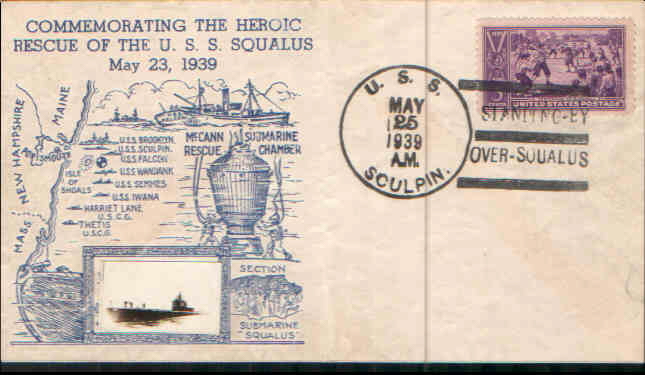
At 0726 john Mihalowski, who had made four trips with the bell to rescue personnel from the submarine, made a dive using the heliox diving system with a new rack arrangement. He stated, "When I landed on the submarine I was breathing heavily for about 30 seconds. I could feel the water on my arms. It was bitterly cold. I was cold from the time I left the surface. I started to feel sort of light-headed and thought I had better come up, so I came up. While I was on the decompression stage the gas supply came in an irregular flow."
Seven more dives were made that day and each of the divers completed his assigned tasks. All used compressed air. E. P. Clayton became fouled in his air hose slack, but was able to clear himself and make a normal ascent.
Day 7: June 1
On this day, off the English coast, the British submarine Thetis sank with a loss of 99 lives. Like the Squalus, she was on her initial sea trials.
Seven dives were made on the Squalus on day seven, all using compressed air. One diver stated, "I was knocked off the descending line, fell about 15 feet and landed in the mud beside the submarine. I climbed back on the boat but was unable to loosen the shackle pin." He was brought up after a 25 minute dive. A second diver stated, "While trying to cut a line loose I dropped my knife. After I found it I felt dizzy. When I increased my air supply I got worse." He was brought to the surface after six minutes.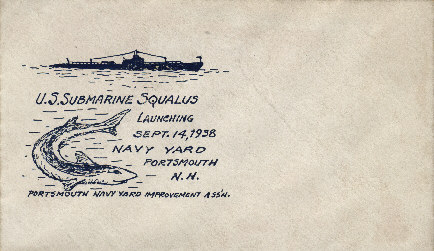
Five dives were completed without incident and all jobs were accomplished. However, it was obvious that working dives to 240 feet were going to present problems. With compressed air the major difficulty seemed to be the effects of nitrogen narcosis. It is known that a build-up of CD 2 in the breathing gas will intensify the effect of nitrogen under pressure. The use of lots of air during the dive helped most divers with the problem but did not eliminate the potential hazards completely. The use of excess air for helmet circulation also increased the possibility of an uncontrolled blow-up from depth.
The use of the basically untried heliox dive helmet and gas system also resulted in problems. The venturi system continued to fail intermittently. This was probably owing to icing of the system that blocked, or partially blocked, the venturi system that recirculated the breathing gas mixture from the CO 2 absorbent canister back into the helmet. Again, a CO 2 build-up, even when using helium, caused problems.
A known factor of using helium mix as the breathing gas is that helium will transfer heat from the body many times faster than compressed air. Because of this the divers using heliox mixes suffered intense cold. Of the 14 dives made on days six and seven, 13 of them used compressed air and were basically uneventful. The dive made using heliox resulted in the diver becoming dangerously cold.
Day 8: June 2
Early on day eight Lieutenant Laing made a dive to 240 feet using a heliox gas mix with a standard air helmet; a straight, open circulation gas supply with no CO 2 scrubbing. He also used another "shocking" first-electrically heated underwear. His statements are revealing. "The dive was a very easy one with no mental disturbance. My faculties were clear at all times." Later in his report he said, "I did experience some communication difficulties due to the fact that I had the hood of the electrically heated underwear over my ears and it was also due to the fact that the lead wire to the underwear worked around between my mouth and the telephone transceiver." Still later in the dive the lieutenant recalled, "Coming up my hands got pretty cold. I called for more heat, which I felt around my body, but which I did not appreciably feel on my hands."
Power for the electrically heated underwear was from a direct current source, either from appropriate battery supply or from some other DC source. Current supply, and therefore the amount of heat to the diver's underwear, was controlled by adding or taking away batteries, or by a system of resistors. Neither system was very accurate, responsive, or reliable. There were also cases of mild, but harmless, shock when wires became bare or the suit got wet for any of several reasons. While not hazardous the occasional shocks were a definite distraction for the diver already affected by depth.
In addition to the equipment problems and the effects of the breathing gases, the lack of experience of the divers in working at 240 feet on a sunken submarine posed problems in the first several days of the operation. The divers' physical condition also played a part since they were not able to cope, in many cases, with the extreme exertion needed. All too often, conditions similar to the one reported by a diver on day 9 occurred: "I missed the submarine and landed on the bottom; got fouled in the hose around the bottom. The exertion caused by working to clear myself tired me out completely and I had to be brought to the surface."
In spite of all the problems, the work continued. The plans called for reinforced hoses to be connected to control room air salvage fittings, forward battery, and forward torpedo rooms. Also, lifting slings were to be swept under the bow of the boat. By May 31 this was done.
during June, more air hoses were connected to the several main ballast tanks. Discharge hoses were connected to the sub's port and starboard fuel oil (diesel) tanks (two on each side). Recovering the fuel from the Squalus proved to be quite simple. Water hoses were led from each fuel tank into an empty tank on the salvage vessel. When sea water flooded the sub's fuel tanks, the diesel fuel "floated" up the hoses and into the salvage vessel's tanks. The tanks on the sub could then be blown dry and used for flotation without creating an environmental problem and a potentially hazardous fuel spill.
Also started in June was an attempt to reeve lifting slings under the stern of the sub by the use of a special water jet lance. The original lance proved unsatisfactory. It was impossible to retain correct alignment and the diver had difficulty making up the sections of the lance while at depth in cold water. Working with the tunneling hoses started on day 10 and the final tunnel was not completed until day 28 (June 22). In the meantime a new lance was designed and constructed.
A seven inch diameter Manila tow line was rigged to the stem of the submarine on June 29. It seemed the salvage work was progressing nicely, but this was day 35. Counting the two days of rescue, the divers had been working for 33 days with only two days off. Even these days were not for relaxation. The entire crew was tired and every task was an accident about to happen. There were several cases of dizziness in the divers; one was knocked off the descending line and fell the rest of the way to the ocean bottom; two missed the decompression stage on the way to the surface and had to descend quickly to the proper depth for the first in-water decompression stop at 80 feet. A warrant officer made one dive to 240 feet, surfaced after six minutes and asked to be transferred.
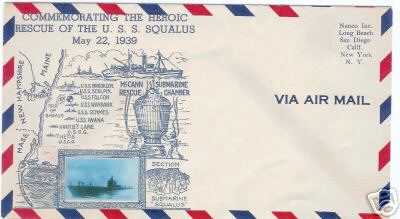
Day 16: June 10
This was a day of near disaster for two divers. 0. S. Payne reached the submarine. He stated, "I started getting dizzy so I stopped to turn on more air to clear my head. The next thing I knew I had been hauled to the surface." His tenders reported he had blown to the surface (made an uncontrolled ascent) owing to excess air in his suit.
W. H. Squire, an experienced master diver, was working in 240 feet of water using a heliox. mix. He reported, "I returned to the descending line and was standing by to come up and that was the end as far as I remember." But there was more, much more, to the story than that. A news article states, "Squire had made a routine dive when he suddenly shot to the surface alongside the salvage ship Falcon. His diving suit, blown up like a toy balloon, was tangled in life lines, air hoses, and descending ropes. Squire floated helplessly on the surface while two divers jumped fully clothed into the sea to untangle the diver and pull him to the side of the ship." Squire suffered an attack of the bends, the first on the job, and had to spend ten hours in the recompression chamber.
In spite of all this, the job was progressing. Diving usually started about 0730. Dives to 240 feet lasted 15 to 20 minutes. The last diver was generally brought on board and placed in the chamber at about 1830 for the 60 minutes of required surface decompression.
Decompression procedures followed for heliox diving were for the diver to take his first decompression stop at 80 or 90 feet. He was then brought to the surface and placed in the recompression chamber where the first decompression stop was repeated. This was followed by the balance of the prescribed decompression for the particular dive, usually about 90 minutes. Sometimes suits were torn and divers got wet with freezing water. Never was a dive a "comfortable" one. Perhaps this job is where the saying originated, "You never ask a diver how he feels. Just ask him where he hurts." Day 22: June 16
On this day there was a third operational submarine disaster. The French submarine Phoenix, with her crew of 71,was lost in 3OO feet of water.
Day 37: July 1
Air hoses were now rigged to the various compartments and tanks of the submarine. Preparations were started to rig and place the huge salvage pontoons that had been brought to the job. Some of them were 32 feet long by 12.5 feet in diameter and had a lifting capacity of 115 tons and a weight of 35 tons. This gave a net lift of 80 tons for each pontoon. Each was divided into three compartments and had blow and vent controls. Hawse pipes were installed in each of the two end compartments through which two and a half inch diameter chains and lifting slings were fitted. At the prescribed depth, a stopper called a "flower pot" -because of its shape-was used. Each of these devices weighed 800 pounds and had to be locked in place by the divers. One end of each pontoon was painted white; the other end red so divers could determine which end needed to be adjusted. On a turning, unpainted pontoon, both ends look the same.
The theory was that the sub would be lightened by blowing water from the various compartments until a negative buoyancy was reached that could be overcome by the pontoons. This would prevent an uncontrolled ascent (with probably disastrous results) since, once the uppermost pontoons reached the surface, the ascent would stop.
Day 40: July 4
At 1831, R. M. Metzger made a dive to one of the salvage pontoons. His report: "Landed on the pontoon. Went to the white end, saw the flower pot was in place. Hammered wedges in the flower pot. Did the same thing to the red end. Came up. The pontoon was level." Metzger was out of the decompression chamber at 1946. It had been atypically long day. News headlines ashore stated, "Pontoons in place to lift Squalus." But were they?
Day 44: July 8
Martin Sibitzky made a dive on YSP-31 (YSP stands for Yard Salvage Pontoon). Sibitzky reported, "Landed on white end of pontoon. It was at an angle of about 30 degrees. Was instructed to open the vent valve, which I did. Then came up."
Day 49: July 13
Five more hard working days had passed. Day 49 came in with gusty winds and rough seas. But F. E. Smith made a dive at 0602 to attach an air hose to the number two main ballast tank. He also opened the blow valve and closed the submarine's control room salvage air valve. How could the divers work and find what they were supposed to? There was now a staggering total of 28,000 feet of ropes, wires, chains, and miscellaneous "things" over the side of the Falcon and connected to the Squalus or to the seven pontoons now rigged in a manner that, it was hoped, would raise the boat. A Portsmouth, New Hampshire paper reported, "Salvage ship blowing air into pontoons on 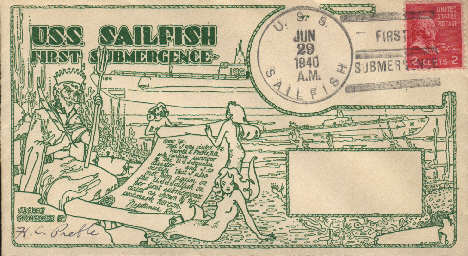 Squalus."
Squalus."
The Falcon had three separate supplies of compressed air. There were two large compressors capable of supplying 150 cubic feet of air per minute at a pressure of 400 psi for the helmet divers. For salvage, two compressors delivered very high volumes of air at 150 psi. Emergency air was stored in large banks of compressed air cylinders. In addition, a large diameter air hose (actually a two and a half inch fire hose being used as an air hose) ran from Sculpin to provide additional air to the salvage manifold. From the manifold, called the "calliope" by the divers, ran dozens of air hoses leading to the many pontoons and submarine fittings far below the surface.
By 0913 compressed air was rapidly displacing the water in both the Squalus and the pontoons. Bubbles were boiling to the surface. Pontoons attached to the stern of the sub came up first under perfect control. First one salvage pontoon and then a second surfaced at the bow. Only one of them was supposed to come completely to the surface. Something was wrong. Moments later the bow of the sunken sub roared out of the water. Very shortly, more than 20 feet of the 1,500 ton boat was above the surface. Headlines ashore told the story: "Squalus shoots to surface, sinks again; 21 divers periled as craft whips the sea."
The next day a Portsmouth newspaper headlined, "Heavy seas prevent divers from learning Squalus damage." Divers were again working underwater by day 52, July 16. The seven pontoons the divers had spent months rigging were tangled with ropes, hoses and chains but were still in place. The divers had done their work well. For five more days, the divers and the salvage crew had to strip away literally miles of wire, hoses and chains to untangle the mess left when the submarine surfaced violently and sank back to the bottom.
Download movie of description of bell operation by on-site Navy Officer
Day 71: August 4
One of the most serious accidents occurred on day 71. E. B. Crosby made a dive to 240 feet using heliox. After 17 minutes he was brought toward the surface. He was given the first three decompression stops in the water at depths of 80,60, and 50 feet, then transferred to the chamber for surface decompression procedures. While being recompressed at about the 50 foot level, he developed a severe pain in his abdomen. The recompression was continued at 130 feet. He responded to treatment and was decompressed to surface pressure over the next three hours. Crosby remained in good condition until about 1800 when he became nauseated and had serious vision problems. He was again placed in the chamber and recompressed to 200 feet. After 20 minutes at depth, his vision was normal and decompression was started again. Crosby's treatment was completed at 1030 on August 6. He was transferred to a hospital on shore for observation. Crosby was back on board the salvage vessel and diving again on August 27 and continued to dive until September 9.
During Crosby's treatment there was no diving since the chamber was not available for surface decompression or for an emergency.
On August 8, a sudden, violent thunderstorm with 50 mile per hour winds whipped the sea, delaying the attempt to raise the Squalus. But on August 12, newspapers told the story, "The sunken submarine was lifted 76 feet today and rested on an even keel." After divers had inspected pontoons, air hoses, and fittings, the Squalus was towed at a speed of one knot toward shore until she again grounded at a depth of 172 feet.
At this shallower depth divers could work longer periods. Rerigging the pontoons went faster now; partly because of the shallower water but also owing to the divers' having a great deal more experience with handling the equipment. Heliox was still used for many of the dives.
Day 80: August 13
It was Sunday and there was no diving on this day. President Roosevelt visited the salvage job.
Day 84: August 17
All was ready and Admiral Cole opted to make the second lift. Again, thousands of feet of hoses were put into service and the water was forced out of the compartments of the sub and the salvage pontoons. The Squalus slowly floated to a preplanned depth of 92 feet. There were no problems and the sub was towed to a shallow area where it was temporarily grounded while the salvage crew made ready for the next lift.
For the next 29 days the salvage crew and divers worked long hours clearing the sub of lines, chains, and hoses and rerigging pontoons, salvage hoses, and tow lines for the final lift and the tow into the harbor and drydock. Now, at a depth of only 92 feet, the divers could work more hours each day. However, fog, turbidity, heavy swells, and ocean currents made jobs even more difficult and hazardous. Thirty~five ton pontoons whipping back and forth in heavy ocean 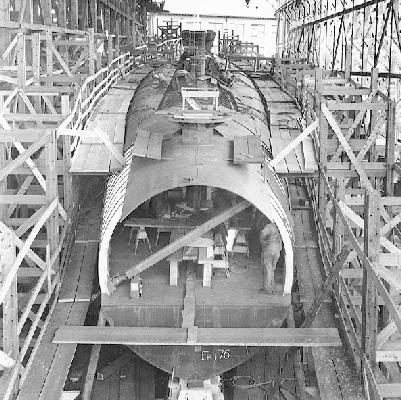 surges were things to be careful about.
surges were things to be careful about.
Day 90: August 23
Martin Sibitzky performed another first. He reported, "Took pictures of Porter (another diver working on the sub with him) and of the submarine as directed. Completed other assigned tasks. Surfaced." This is the only reference to underwater photography noted in all the reports on the salvage of the Squalus.
Day 93: August 26
William Squire and Henry Frye made a dive and reported, "Working together we took off the main engine induction valve cover plate, took off the cap, screwed the valve down 43 turns." Finally, the valve that had failed to close on May 23, causing the Squalus to sink, was closed to the Atlantic Ocean. Day 95: August 28
The British submarine Thetis was raised this day and towed to drydock where her 99 dead were removed.
The Squalus was ready for what was hoped would be the last lift. High pressure air roared into the two pontoons and into the hull of the sub. The bow came to the surface first. But the vessel listed heavily to starboard, spilled out the air, and sank again.
Later that day another attempt was made to float the sub. The stern was blown dry with compressed air. All the water in the hull rushed to the forward part of the vessel and the sub sank.
Two weeks of intermittent squally weather and rough seas followed. Divers and salvage crews fought the elements.
On shore, newspapers told part of the story, "September 2: Naval officials announced tonight that a pontoon had knocked off an after torpedo room hatch during the storm this week. A new hatch and a buffer to protect it would have to be installed." The following day Duncan and Crosby (the diver who had suffered the serious case of the bends) made a dive on the sub. Crosby reported, "Duncan and I hauled the new hatch cover that was sent down over to the hatch and secured it." The dive lasted 40 minutes.
Pontoons had also been damaged during the storm and had to be replaced.
Day 100: September 2
Diver Metzger suffered a bends hit in his left arm. He was treated and there were no residual symptoms. He returned to duty and made one more dive on September 9.
From September 9-12 heavy seas hampered the final placement and rigging for lifting and towing the Squalus. Headlines in Portsmouth papers told the story- "September 11 . Last Squalus lift due tomorrow." 'Men, "September 12. Squalus final lift slated tomorrow." And again, "September 13. Squalus lifted, but sinks again." This was a report as of 0955. Later that day the Squalus was again floated to the surface. This time she was nearly on an even keel and the slow tow to Portsmouth and drydock began.
Day 112: September 14
"Delay again dogs Squalus salvage crew:" Such was a headline in a Portsmouth paper after the sub was docked temporarily. "The stern of the submarine, berthed at the Navy Yard pier, sank below the surface." The sea was still reluctant to give up its dead. Later that night the salvage crew finally won out against her. The stern was raised and the vessel put on an almost even keel. A few minutes before midnight the doomed shipmates were removed from the vessel.
The Squalus was drydocked the next day-September 15, 1939; 113 days after it sank. The vessel was exactly one year old. President Roosevelt formally commended the "devotion to duty, courage, skill, initiative, and self sacrifice" of the officers and men who salvaged the sunken submarine. Every diver who worked on the Squalus received an award-from Congressional Medals of Honor (4), to Navy Crosses (49), to citations from the Secretary of the Navy (4). And, every one of those awards was well earned.
End
